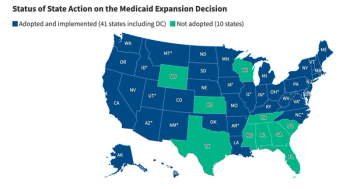
Inpatient Telehealth Adoption Surges
Telehealth being used to fill patient care gaps.
The use of telehealth services has surged inâ¯
In this survey, data and analytics company Definitive Healthcare polled healthcare providers in the C-Suite and IT directors/VP categories to determine
The Definitive Healthcare 2019 Inpatient and Outpatient Telehealth Studies are conducted annually to highlight the historical trends of hospitals and health systems as they begin implementing telehealth technology and services in their approach to patient care. This is the fifth iteration of Definitive Healthcare’s Inpatient Telehealth Study, and the third iteration of the Outpatient Telehealth Study.
Related article:
“These studies highlight a positive outlook for the adoption of telehealth to increase patient access to care and enhance physician communication while continuing to move technological advancements in the space forward,” according to Kate Shamsuddin, senior vice president of strategy at Definitive Healthcare. “Whether urban or rural hospital, academic medical center or critical access facility, organizations are finding new and creative ways through telehealth to fill gaps in patient care, increase care access, and provide additional services to patient populations outside the walls of their hospital.”
Inpatient findings include:
- Inpatient telehealth adoption rate rising. Adoption of telehealth solutions or services has surged since this study was first conducted from roughly 54% in 2014 to 85% in 2019, indicating a higher level of acceptance and desire for telehealth solutions and services.
- Technology mix. Specific technologies that have shown considerable adoption gains are two-way video/webcam and the use of population management tools such as texting, while remote patient monitoring through clinical grade devices continues to show improved adoption rates but at a slower pace. Hospitals and health systems tend to have a broader mixture in the types of technologies they use, due to their larger budgets and scale.
- Re-investment. Plans for future telehealth investment have increased significantly from 26% in 2016 to 40% in 2019; 90% of future investment plans are slated to occur within the next 12 to 18 months.
- Barriers. Cost was named the primary barrier to adoption for inpatient providers.
Outpatient findings include:
- Adoption remains flat 2018 to 2019. Adoption rates of telehealth solutions/services by outpatient physician practices remained relatively flat from 2018 to 2019, lingering at about 44%.
- Technology mix. The mix of telehealth technology solutions shifted this year, with an increase in two-way video/webcam, mobile applications for concierge services, and clinical grade remote patient monitoring devices.
- Re-investment. Roughly 65% of physician practices with a telehealth solution already in place plan to make further investments (up from 45% in 2018). Nearly 90% that plan to make an investment plan to do so in the next 18 months.
- Barriers. One in five outpatient respondents cited "satisfaction with the practice's current solutions and services" as a primary obstacle to adoption.
The findings of the 2019 Outpatient Study showed that while 44% of respondents have adopted telehealth technology there is still a divide between hospital-owned and nonhospital-owned practices, as roughly 55% of hospital-owned practices have adopted telehealth technology versus 37% for nonhospital-owned.
“As healthcare organizations continue to expand their reach to patients and fellow providers, we anticipate that telehealth will be one of the core linchpins for providers,” says Shamsuddin. “Providers in a variety of settings are keeping a close watch on the telehealth market, particularly as the technology continues to mature and CMS/private payer reimbursement policies continue to expand. Many of the providers who are hesitant to implement are simply waiting to learn about their many options and determine the ROI associated with these solutions.”
Based on the survey, there are four things healthcare executives should know about telehealth:
- Telehealth technology and services can improve care access by ensuring that remote or rural patients have access to necessary and specialized healthcare services.
- With healthcare moving from fee-for-service to value-based care and with the increased focus on population health, patient engagement, and more personalized care delivery, telehealth solutions and services can help bridge numerous gaps that exist in the current healthcare landscape.
- Currently, the telehealth vendor market share at U.S. hospitals is varied. According to Definitive Healthcare data, InTouch Health, Polycom, Cisco Systems, Nighthawk Radiology Services andâ¯VRad have the most reported installations across U.S. hospitals-each possessing 8% or more of the market share.
- Minnesota, South Dakota, and Utah have the highest reported telehealth implementations with 57% or more of the state’s hospitals reporting a solution. A number of hospitals in the Northeast, Southeast, and Southwest regions of the country currently report the lowest level of adoptions, and therefore are prime for opportunity.
Looking ahead, the surveys will evolve to include questions that evaluate different types of telehealth technologies and their effectiveness, as implementation rates start to flatten. Both surveys will also begin to examine more closely the return on investment (ROI) providers are getting from telehealth platforms and their success in furthering population health and patient management goals.
Newsletter
Get the latest industry news, event updates, and more from Managed healthcare Executive.





















































